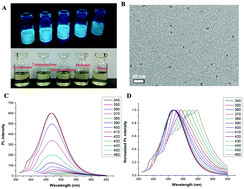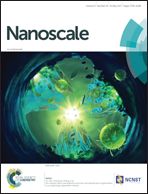Amphiphilic carbon dots as versatile vectors for nucleic acid and drug delivery†
Abstract
Carbon dot (CD)-based multifunctional delivery systems have shown great potential in both drug/gene delivery and bio-imaging. In this work, we present a strategy to simply construct amphiphilic CDs (ACDs) by conjugating hydrophobic alkyl epoxide to the surface amino groups of PEI 600-derived CDs. ACDs could well dissolve in water or organic solvents and emit bright fluorescence both in solutions and cells. 1HNMR also suggested that ACDs may form micelle-like structures in water, and their CMC could be determined. Enhanced green fluorescent protein (EGFP) expression and flow cytometry experiments showed that ACDs have higher transfection efficiency than Lipofectamine 2000 in A549 cells. Besides DNA, ACDs could also effectively transfect Sur siRNA toward A549 cells and cause early cell apoptosis. The 3D multicellular spheroids further confirmed their high potential for delivering therapeutic genes into the tumor tissue. On the other hand, ACDs also exhibited good drug loading ability. CLSM experiment results showed that DOX could be effectively internalized by the cell and slowly released from the drug/ACD complex. These results suggest that ACDs may not only serve as versatile delivery vectors with potential for applications in clinical cancer treatment, but also offer an inspiration for the discovery of CD-based gene/drug delivery systems.



 Please wait while we load your content...
Please wait while we load your content...